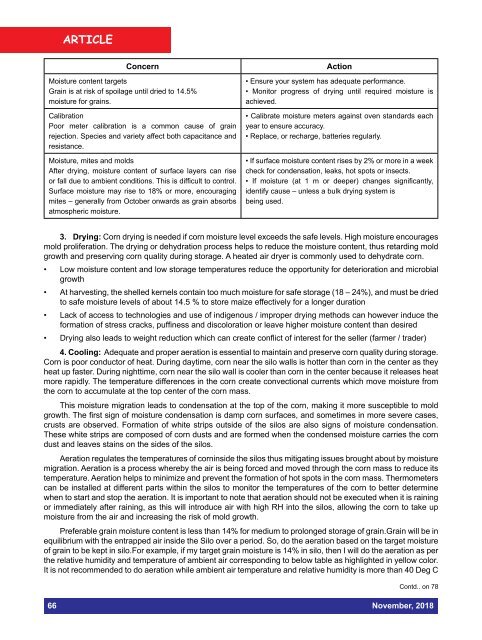November 2018 Punch PDF
Create successful ePaper yourself
Turn your PDF publications into a flip-book with our unique Google optimized e-Paper software.
ARTICLE<br />
Concern<br />
Moisture content targets<br />
Grain is at risk of spoilage until dried to 14.5%<br />
moisture for grains.<br />
Calibration<br />
Poor meter calibration is a common cause of grain<br />
rejection. Species and variety affect both capacitance and<br />
resistance.<br />
Moisture, mites and molds<br />
After drying, moisture content of surface layers can rise<br />
or fall due to ambient conditions. This is difficult to control.<br />
Surface moisture may rise to 18% or more, encouraging<br />
mites – generally from October onwards as grain absorbs<br />
atmospheric moisture.<br />
Action<br />
• Ensure your system has adequate performance.<br />
• Monitor progress of drying until required moisture is<br />
achieved.<br />
• Calibrate moisture meters against oven standards each<br />
year to ensure accuracy.<br />
• Replace, or recharge, batteries regularly.<br />
• If surface moisture content rises by 2% or more in a week<br />
check for condensation, leaks, hot spots or insects.<br />
• If moisture (at 1 m or deeper) changes significantly,<br />
identify cause – unless a bulk drying system is<br />
being used.<br />
3. Drying: Corn drying is needed if corn moisture level exceeds the safe levels. High moisture encourages<br />
mold proliferation. The drying or dehydration process helps to reduce the moisture content, thus retarding mold<br />
growth and preserving corn quality during storage. A heated air dryer is commonly used to dehydrate corn.<br />
• Low moisture content and low storage temperatures reduce the opportunity for deterioration and microbial<br />
growth<br />
• At harvesting, the shelled kernels contain too much moisture for safe storage (18 – 24%), and must be dried<br />
to safe moisture levels of about 14.5 % to store maize effectively for a longer duration<br />
• Lack of access to technologies and use of indigenous / improper drying methods can however induce the<br />
formation of stress cracks, puffiness and discoloration or leave higher moisture content than desired<br />
• Drying also leads to weight reduction which can create conflict of interest for the seller (farmer / trader)<br />
4. Cooling: Adequate and proper aeration is essential to maintain and preserve corn quality during storage.<br />
Corn is poor conductor of heat. During daytime, corn near the silo walls is hotter than corn in the center as they<br />
heat up faster. During nighttime, corn near the silo wall is cooler than corn in the center because it releases heat<br />
more rapidly. The temperature differences in the corn create convectional currents which move moisture from<br />
the corn to accumulate at the top center of the corn mass.<br />
This moisture migration leads to condensation at the top of the corn, making it more susceptible to mold<br />
growth. The first sign of moisture condensation is damp corn surfaces, and sometimes in more severe cases,<br />
crusts are observed. Formation of white strips outside of the silos are also signs of moisture condensation.<br />
These white strips are composed of corn dusts and are formed when the condensed moisture carries the corn<br />
dust and leaves stains on the sides of the silos.<br />
Aeration regulates the temperatures of corninside the silos thus mitigating issues brought about by moisture<br />
migration. Aeration is a process whereby the air is being forced and moved through the corn mass to reduce its<br />
temperature. Aeration helps to minimize and prevent the formation of hot spots in the corn mass. Thermometers<br />
can be installed at different parts within the silos to monitor the temperatures of the corn to better determine<br />
when to start and stop the aeration. It is important to note that aeration should not be executed when it is raining<br />
or immediately after raining, as this will introduce air with high RH into the silos, allowing the corn to take up<br />
moisture from the air and increasing the risk of mold growth.<br />
Preferable grain moisture content is less than 14% for medium to prolonged storage of grain.Grain will be in<br />
equilibrium with the entrapped air inside the Silo over a period. So, do the aeration based on the target moisture<br />
of grain to be kept in silo.For example, if my target grain moisture is 14% in silo, then I will do the aeration as per<br />
the relative humidity and temperature of ambient air corresponding to below table as highlighted in yellow color.<br />
It is not recommended to do aeration while ambient air temperature and relative humidity is more than 40 Deg C<br />
Contd.. on 78<br />
66 <strong>November</strong>, <strong>2018</strong>





